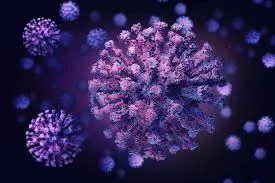The COVID-19 pandemic is an ongoing global pandemic caused by severe acute respiratory syndrome coronavirus 2 (SARS-CoV-2). Scientists have developed multiple ways to test for infections. Commonly used methods in Asia include polymerase chain reaction (PCR) test, blood antibody test and self-administered antigen rapid test (ART). Recently, Singapore scientists have developed a new form of ART, which detects the presence of virus in saliva, including the latest Omicron variant.

Figure 1. SARS-CoV-2 3D Model
How is it carried out?
Unlike the traditional ART, which people put the swab deep into the nasal cavity, the saliva ART is much less invasive, and could be done in a similar fashion as a pregnancy test.
- Spit saliva into the aseptic cup
- Use dropper to take up the saliva
- Put three drops into channel 1 on the testing strip
- In channel 1, virus binds to the red coloured nanoparticles and travels up to the reporting window
- 2 lines at reporting window indicate a positive infection
- If there is only 1 line at C region, put another 3 drops of saliva into channel 2
- Channel 2 has similar nanoparticles as channel 1, but it amplifies the binding process and thus the signal of infection
- 2 lines at reporting window indicate a positive infection; 1 line at C region indicate that a person is not infected with COVID.
The whole process takes around 15 minutes and can be done any time in a day. Once approved, it can be done anywhere at patient’s discretion.

Figure 2. Saliva ART Kit
How does it compare to other existing tests?
PCR test
- PCR test is the most used COVID testing method worldwide. A nasal swab is taken by health professionals, with samples processed at local lab to detect the presence of viral genetic material. PCR tests takes 1 to 3 days to get a result depending on local lab availability. It must be performed at medical lab and samples must be transported from where they are taken.
- Both PCR and saliva antigen tests have very high sensitivity rate (ability to detect positive patients): above 99.5% for PCR test and 97% for saliva ART.
Antigen Rapid Test (ART)
- Traditional ART is done through patients taking a sample from nasal cavity. People can perform this at home or at community GP clinic. Results usually comes out in 15 to 30 minutes depends on the brand. Most products have a sensitivity of above 80%.
A summary table comparing different type of COVID tests
| Test | Procedure | Efficiency | Accuracy |
| Polymerase Chain Reaction (PCR) Test |
|
1 to 3 days depends on local lab availability | Above 99.5% sensitivity rate (ability to detect people who are positive) |
| Antigen Rapid Test (ART) |
|
15 to 30 minutes depends on brand | Above 80% sensitivity rate |
| Saliva Antigen Rapid Test (ART) |
|
15 minutes | Around 97% sensitivity rate |
Where can I buy saliva ART kit?
As of 10th December 2021, authority in Singapore is reviewing the application from the development team to start the production process. The experimental data has been published on Microchimica Acta, a widely known peer-reviewed journal in medical field. Looking ahead, saliva ART could offer people with more choices in the form of tests available, more comfortable testing experience, without compromising the reliability of testing results.
